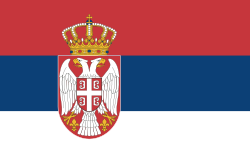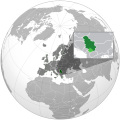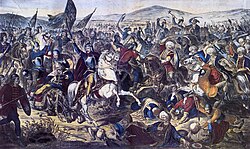Serbia
Coordinates: 44°N 21°E / 44°N 21°E
Serbia (Serbian: Република Србија / Republika Srbija), officially the Republic of Serbia (Serbian: Србија / Srbija), is a country in Southeastern Europe, and a part of the Balkans. The capital city is Belgrade. To the north of Serbia is the country Hungary. To the east of Serbia are the countries Bulgaria and Romania. To the south of Serbia is the country North Macedonia and Kosovo. To the west of Serbia are the countries Montenegro (the country that was once united with Serbia), Bosnia and Herzegovina and Croatia.
Republic of Serbia Република Србија (Serbian Cyrillic)
Republika Srbija (Serbian Latin) | |
|---|---|
| Anthem: | |
 Location of Serbia in (green) and Europe in (dark grey). | |
| Capital and largest city | Belgrade 44°48′N 20°28′E / 44.800°N 20.467°E |
| Official languages | Serbian |
| Ethnic groups (2011) |
|
| Demonym(s) | Serbian |
| Government | Unitary parliamentary constitutional republic |
| Aleksandar Vučić | |
| Miloš Vučević | |
| Legislature | National Assembly |
| Formation | |
| late 8th century | |
| 1217/1346 | |
| 1459–1556 | |
| 1815 | |
| 1878 | |
| 1912–1918 | |
• Independent republic | 5 June 2006 |
| Area | |
• Including Kosovo | 88,361 km2 (34,116 sq mi) (111th) |
• Excluding Kosovo | 77,474 km2 (29,913 sq mi)[1] |
| Population | |
• 2017 estimate | 7,040,272 (excluding Kosovo) |
• Density | 91.1/km2 (235.9/sq mi) (121th) |
| GDP (PPP) | 2018 estimate |
• Total | $112.475 billion[3] (78th) |
• Per capita | $16,063 (excluding Kosovo)[3] (83rd) |
| GDP (nominal) | 2018 estimate |
• Total | $42.378 billion[3] (86th) |
• Per capita | $6,052 (excluding Kosovo)[3] (88th) |
| Gini (2013) | 29.6[4] low |
| HDI (2015) | high · 66th |
| Currency | Serbian dinar (RSD) |
| Time zone | UTC+1 (CET) |
• Summer (DST) | UTC+2 (CEST) |
| Driving side | right |
| Calling code | +381 |
| ISO 3166 code | RS |
| Internet TLD | |
| |
Politics
Serbia is trying to join the European Union. According to the European Commission report in 2023 it is doing too little to settle its differences with Kosovo. Its foreign policy is too close to Russia. There is too much corruption and organised crime. Media independence is weak. Aleksandar Vulin, the head of the state security agency, has been sanctioned by the USA for his links to crime, Russia and “promoting ethno-nationalist narratives that fuel instability in Serbia and the region”.[6]
History
An ancient civilization which inhabited Serbia is called the Vinča culture and used symbols that are called the Vinča script[7] Some people think they are the first writing system. Serbia is also home to the earliest known copper smelting sites and the birth of the Copper Age when people left the Stone Age and went into regular use of metallurgy.[8] The same culture contains the earliest evidence of tin alloy bronze which replaced the much weaker arsenic bronze.[9]
Medieval history
White Serbs, an early Slavic tribe from Northern Europe, came to Northern Greece in the 6th century. By the 8th century they had created the Serbian Principality, a Serbian country, in the Balkans.[10] The Serbs became Christian around the 10th century. For 200 years, the Nemanjić dynasty ruled. They made Serbia a kingdom, built new towns, monasteries, and forts, and made Serbia bigger. In 1371 the Nemanjic Dynasty died out. Serbia became unsafe and local leaders fought each other for control. After the Battle of Kosovo 1389 the Ottoman Empire fought the Serbs for 70 years until in 1459 the Ottoman Turks conquered Serbia[11] and other Balkan countries.
Ottoman period
Once the Ottomans conquered Serbia, they got rid of the Serbian upper class. Most Serbs worked as farmers on land owned by Turks. They had to pay high taxes to the Turks. Some Serbs became Muslims. Serbs had their own laws in the Ottoman Empire through the millet system.[12][13] The Christian Austrian Empire fought the Turks many times, including in the Great Turkish War of the late 17th Century. In 1718 Austria took northern Serbia and some other places. The last Austro-Turkish war was in 1781-1791.
During the 19th century Serbia gradually became independent. During World War I Austria conquered Serbia but lost the bigger war. Serbia joined other Balkan countries to form Yugoslavia.
Geography
Serbia is found in the Balkan peninsula and the Pannonian Plain. The Danube passes through Serbia. Over 31% of Serbia is covered by forest.[14] National parks take up 10% of the country's territory.[15] Serbia has 5 national parks and 22 nature reserves.
Birds
Serbia is on the Vardar-Morava Flyway of bird migration, so many birds fly across Serbia when going to Africa and back. Golden Eagle, Nutcracker and Coal Tit live high in the mountains. Nightingale, Chaffinch and Greater Spotted Woodpecker live in the forests in the hills. Saker Falcon, Whinchat and Quail live in steppe and fields in the northern lowland part of Serbia which is called Vojvodina. Syrian Woodpecker, Common Redstart and Collared Dove live in the orchards and farmyards. Black Redstart, Kestrel and Common Swift live in the city center. The Hooded Crow lives everywhere.
The town of Kikinda is known for Long-eared Owls that form flocks in trees at the city squares. Tourists come from other countries to see them. In winter you can see Pygmy Cormorants in Belgrade, at the rivers Sava and Danube.
Economy
Serbia is classed as an upper-middle income economy.[16]
The major processed vegetable crops in Serbia are potatoes, tomatoes and pepper.[17] Serbia is one of the biggest world producers and exporters of raspberries.[18] They are a leading exporter of frozen fruit.[19]
There are four international airports in Serbia: Belgrade Nikola Tesla Airport, Niš Constantine the Great Airport, Morava International Airport, and Vršac International Airport.
89% of households in Serbia have fixed telephone lines. There are over 9.60 million cell-phones users. This is larger than the number of the total population of Serbia itself by 30%.
Culture
Serbia has a total of eight sites on the UNESCO World Heritage list: The Early Medieval capital Stari Ras and the 13th-century monastery Sopoćani, and the 12th-century monastery Studenica, and the endangered Medieval Monuments in Kosovo group, comprising the monasteries of Visoki Dečani, Our Lady of Ljeviš, Gračanica and Patriarchate of Peć (former seat of the Serbian Church, mausoleum of Serbian royalty) and finally the Roman estate of Gamzigrad–Felix Romuliana. There are two literary memorials on UNESCO's Memory of the World Programme: The 12th-century Miroslav Gospel, and scientist Nikola Tesla's valuable archive.
The most prominent museum in Serbia is the National Museum of Serbia. It was founded in 1844. It houses a collection of more than 400,000 exhibits, over 5,600 paintings and 8,400 drawings and prints, and includes many foreign masterpiece collections, including Miroslav Gospel.
The official language, Serbian, is written in both the Cyrillic and Latin alphabets.
Composer and musicologist Stevan Stojanović Mokranjac is said to be one of the most important founders of modern Serbian music.[20][21]
In the 1990s and the 2000s, many pop music performers rose to fame. Željko Joksimović won second place at the 2004 Eurovision Song Contest. Marija Šerifović won the 2007 Eurovision Song Contest. Serbia was the host of the Eurovision Song Contest 2008.
Sports
The most popular sports in Serbia are football, basketball, volleyball, handball, water polo and tennis.
The three main football clubs in Serbia are Red Star and Partizan, both from the capital city of Belgrade, and Vojvodina from Novi Sad.
Novak Djokovic, a multiple Grand Slam-winning tennis player and current number one, is from Serbia. Other tennis players from Serbia include Ana Ivanovic and Jelena Jankovic.
Serbia Media
National anthem of Serbia, performed by the United States Navy Band
Vinča culture figurine, 4000–4500 BC
Remnants of the Felix Romuliana Imperial Palace, 298 AD, a UNESCO World Heritage Site; Some historians believe as many as 18 Roman emperors were born in modern-day Serbia
The Coronation of the tsar Stefan Dušan, known as Dušan the Mighty, in Skopje, as Emperor of Serbs and Greeks in 1346
The Battle of Kosovo in 1389 is particularly important to Serbian history, tradition and national identity
The Serbian Revolution, led by Karađorđe and Miloš Obrenović, marked the foundation of modern Serbia
King Peter I of Serbia led the nation during the Great Serbian Retreat in 1915. Serbia lost about 850,000 people, a quarter of its pre-war population.[22]
Related pages
References
| Wikimedia Commons has media related to Lua error in Module:Commons_link at line 62: attempt to index field 'wikibase' (a nil value).. |
| Wikivoyage has a travel guide about: Serbia |
- ↑ "The World Factbook: Serbia". Central Intelligence Agency. 20 June 2014. Archived from the original on 24 December 2018. Retrieved 18 December 2014.
- ↑ "PBC stats". stat.gov.rs. 2018. Archived from the original on 4 September 2019. Retrieved 17 August 2018.
- ↑ 3.0 3.1 3.2 3.3 "Serbia". International Monetary Fund. Archived from the original on 14 February 2018. Retrieved 23 January 2018.
- ↑ "Human Development Reports: Gini coefficient". hdr.undp.org. United Nations Development Programme. Archived from the original on 10 June 2010. Retrieved 20 January 2018.
- ↑ "2016 Human Development Report" (PDF). United Nations Development Programme. 2016. Archived (PDF) from the original on 22 March 2017. Retrieved 25 March 2017.
- ↑ Barber, Tony (2023-11-12). "Serbia is a poor fit for EU enlargement plans". Financial Times. https://www.ft.com/content/548c6093-2853-4e9a-b39d-1580a6190403. Retrieved 2023-11-12.
- ↑ "THE VINCHA SCRIPT". www.korenine.si. Archived from the original on 10 January 2015. Retrieved 4 November 2016.
- ↑ http://m.megalithic.co.uk/article.php?sid=2146413558
- ↑ "6,500-year old tin-bronze from Serbia - HAEMUS - Center for scientific research and promotion of culture".
- ↑ Sima M. Ćirković, SRBI MEĐU EUROPSKIM NARODIMA,(Serbs) 2008. http://www.mo-vrebac-pavlovac.hr/attachments/article/451/Sima%20%C4%86irkovi%C4%87%20SRBI%20ME%C4%90U%20EVROPSKIM%20NARODIMA.pdf Archived 2020-01-08 at the Wayback Machine #page=26-27
- ↑ Fine, John (1994). The Late Medieval Balkans: A Critical Survey from the Late Twelfth Century to the Ottoman Conquest. University of Michigan Press. p. 575. ISBN 9780472082605. Archived from the original on 15 January 2023. Retrieved 24 February 2022.
- ↑ Runciman 1968, p. 204.
- ↑ Kia 2011, p. 115.
- ↑ "Dragin obrazlozio predloge zakona u oblasti poljoprivrede". Vlada Srbije. 2005. Archived from the original on 26 October 2012. Retrieved 30 September 2012.
- ↑ "U Srbiji do 2010. godine 10% teritorije nacionalni parkovi". Poslovni Magazin – Business Surfer. Archived from the original on 22 June 2008. Retrieved 28 April 2010.
- ↑ "Upper-middle-income economies". The World Bank. Archived from the original on 24 May 2008. Retrieved 30 September 2012.
- ↑ Marat Terterov (2006), Doing Business with Serbia, p. 169, ISBN 9781905050680
- ↑ Caucaso, Osservatorio Balcani e. "Raspberries, Serbia's Red Gold". Osservatorio Balcani e Caucaso. Archived from the original on 12 November 2020. Retrieved 11 February 2019.
- ↑ Borka Tomic (13 April 2006). "Rebranding Serbia". Invest in Serbia. Archived from the original on 13 May 2011. Retrieved 30 September 2012.
- ↑ "Projekat Rastko: Istorija srpske kulture". Rastko.rs. Archived from the original on 3 June 2012. Retrieved 24 May 2012.
- ↑ "Stevan Stojanović Mokranjac (1856—1914)". Riznicasrpska.net. 28 September 1914. Archived from the original on 26 September 2013. Retrieved 24 May 2012.
- ↑ Sudetic 1992, p. 28.
- Runciman, Steven (1968). The Great Church in Captivity: A Study of the Patriarchate of Constantinople from the Eve of the Turkish Conquest to the Greek War of Independence (1. ed.). Cambridge: Cambridge University Press. ISBN 9780521071888.
- Kia, Mehrdad (2011). Daily Life in the Ottoman Empire. Santa Barbara, California: Greenwood Press. ISBN 9780313064029.








